|
1.
CENTRAL/ WEST AFRICA
Business inactive as Europe breaks for holidays
Trade continues very subdued in West Africa, with
European buyers out of the market as the Christmas and
New Year¡¯s holiday period approaches. The European
manufacturing sector has already been hard hit by the
economic downturn. Those producing doors, door sets,
windows and roof trusses have been badly affected and
consumption of both hardwood and softwood has fallen to
very low levels. Importers and merchants say that demand
has been weak and that stock reduction continued to be the
main focus.
The impact of slow business on West African exporters
has been minimized by the curtailment in production.
However, the effects of this have now begun to cause
concern in government forestry and financial departments
as tax revenues in forest operations, production activities
and export taxes have been far lower than expected, while
unemployment in the timber sector has become a serious
problem. Producers in turn complain that taxes have been
too high given their current financial situation.
Exports of logs to the Asian region have been fairly active
for the reduced number of exporters able to offer prompt
shipments in moderate volumes.
For sawn lumber, there has been little relief in sight. Prices
for sapele and some other lumber species have fallen
marginally, though firm orders were very few and, with
low production volumes, producers were not disposed to
accept low offers. Lead times for new orders for special
sizes have said to be extended and prices for specials have
at times been above those for regular specifications.
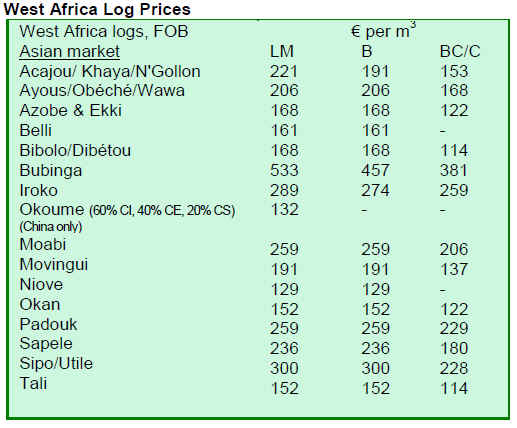
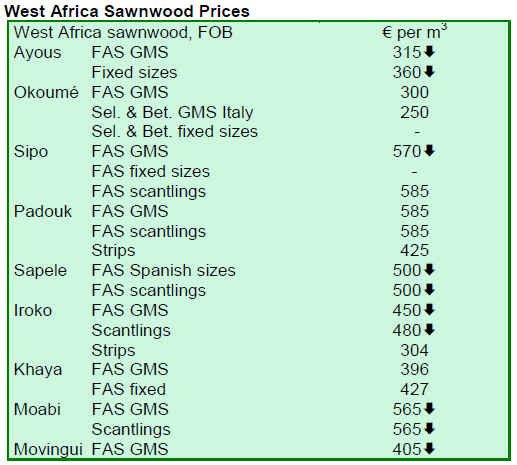
2. GHANA
Ghana¡¯s timber exports rise by volume and value
Ghana¡¯s total exports of timber and wood products for the
first nine months of 2008 increased to 430,100m³, a 7.7%
rise when compared to the same period in 2007. The
corresponding total revenue for the first three quarters also
increased 4.2% to EUR144.42 million in 2008, up from
EUR135.55 million in 2007.
The gain resulted from higher volumes recorded for sliced
veneer (13.6%), plywood (8.7%), rotary veneer (7.5%)
and kiln-dried lumber (4.3%). Decreases in volume were
recorded for furniture parts (82.6%), curl veneer (35.5%),
boules (34.7%) and air-dried lumber (12.9%) as shown in
Table 1 below:
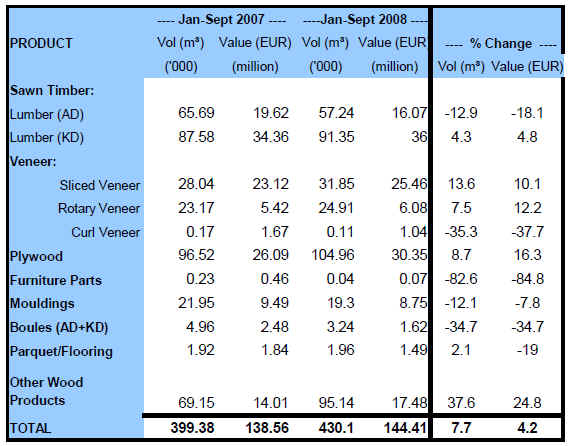
Table 1: Ghana¡¯s Timber Export Statistics, January-September 2007-
2008 (Note: 1- lumber (AD) includes lumber overland; 2-sliced veneer
includes layons; 3- plywood includes overland)
Plywood (24.4%), kiln-dried lumber (21.2%), air-dried
lumber (13.3%), sliced veneer (7.4%) and rotary veneer
(5.8%) altogether accounted for 72.2% of the total volume
exports during the period, with twelve other products
accounting for 27.8%.
Plywood exports, including overland exports, during the
period recorded an 8.7% increase in volume over that of
the previous year to reach 104,960 m³. The corresponding
revenue was EUR30.35 million, showing a 16.3% rise in
2008 compared to the same period in 2007. The three
leading exporters were Naja David Veneer & Plywood,
John Bitar & Co. Ltd. and Asuo Bomosadu Timbers,
which contributed 70.0% of total volume exported. The
main species were ceiba, chenchen and mahogany, and the
leading importing countries were Nigeria, Burkina Faso,
Niger and Togo.
Kiln-dried lumber rose from 34,360 m³ in 2007 to 36,000
m³ in 2008 during the first three quarters registering
increases of 4.3% and 4.8% in volume and value,
respectively. Of the 96 exporters, the two leading
companies were Ayum Forest Products Ltd. (12.0%) and
Samartex Timber and Plywood (9.9%). When compared to
2007, air-dried lumber exports suffered a decline of 12.9%
in volume with a corresponding 18.1% decrease in
revenue for the period January ¨C September 2008.
Sliced veneer export rose 13.6% to record 25,460 m³ for
2008 against 23.12% registered for 2007 during the same
period. The main leading exporters were Logs and Lumber
Co. Ltd. and John Bitar Co. Ltd., which together
accounted for 49.2% of total export volume with revenues
of EUR11.2 million.
Total rotary veneer exports for the first three quarters were
EUR24,910 m³, a 7.5% gain over 2007 figures. The
corresponding revenue for the same period also rose from
EUR5.42 million in 2007 to EUR6.08 million in 2008.
Tertiary products accounted for EUR10.86 million of the
EUR144.42 million earned in 2008 as against Euro 12.27
million from the total revenue of EUR138.55 million of
wood export for the same period in 2007. Secondary
products for the January ¨C September 2008 period were
also EUR133.56 million as compared to EUR126.28
million in 2007.
Ghana¡¯s trade was notably directed to the European Union
(EU), which accounted for 45.04% and 33.25% of the total
export volume and value, respectively, for the period
under consideration. The key markets in the EU included
France, Germany, the UK, Belgium, Spain, Ireland and
Holland.
The US accounted for 9.01% and 12.66% of the total
export volume and value, respectively, in contrast to the
period compared 10.23% and 13.33% in 2007. The US
market maintained its dominance as the largest destination
market for Ghana¡¯s lumber (KD) and rotary veneer
exports.
The ECOWAS market (mainly Senegal, Nigeria, Niger,
Gambia, Mali, Benin, Burkina Faso and Togo) also
absorbed EUR30.35 million (96.54%) of Africa¡¯s
EUR31.44 million wood imports from Ghana during the
period. Plywood and lumber (air-dried) continued to
interest the Nigeria, Niger, Burkina Faso and Senegalese
markets.
The emerging markets in Asia and the Far East - India,
Malaysia, Taiwan, China, Singapore and Thailand -
altogether contributed EUR23.07 million (15.97%) to
Ghana¡¯s total of wood export value during January ¨C
September 2008. India continues to be the leading
importer of teak lumber (AD).
The Middle East countries, notably Saudi Arabia,
Lebanon, United Arab Emirates and Israel, together
represented EUR7.88 million (5.46%) of the total export
value for the period.
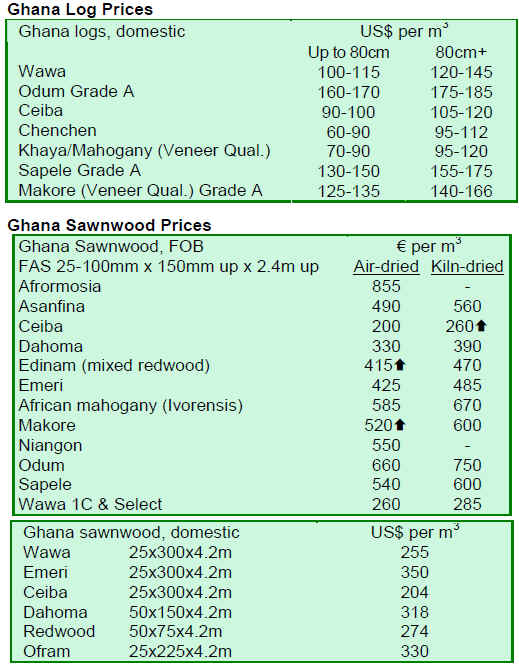
3.
MALAYSIA
Sarawak merchants seek favorable production trends from China
Log prices in Malaysia began to stabilize, particularly in
West Malaysia, where the year-end monsoon has caused
widespread flooding and landslides, making it difficult and
dangerous for the harvesting of logs. Timber merchants in
Sarawak are hopeful that China will increase its imports of
logs from the east Malaysian state at the end of the winter
season. Wood Resources International recently reported
that China¡¯s timber production has substantially increased
over the first seven months of 2008, although production
was expected to be down during most of the fourth quarter
of 2008. Timber merchants from Sarawak have also faced
enormous competition from New Zealand, which has
increased its export of radiata pine logs to China during
third quarter 2008, up about 58% from third quarter 2007
levels. Nevertheless, traders in Sarawak are hopeful
production trends in China will turnaround in 2009 and
offer promising opportunities.
Malaysia furniture makers take interest in Saudi Arabian markets
Furniture manufacturers continued to take interest in the
Kingdom of Saudi Arabia. According to a report by Jones
Lang LaSalle, a leading international real estate
investment and advisory firm, the Saudi Arabian real
estate market is expected to grow substantially over the
next four years. The country has had over five years of
continued economic growth, with GDP increasing on
average 15% annually since 2002.
Despite this news, sawnwood processors and wooden
furniture manufacturers were facing sharp challenges,
reported the Khaleej Times, as raw material supply
continued to tighten and the Gulf Cooperation Council
(GCC) countries¡¯ real estate and construction industries
began to slow down. Banks in the GCC, especially Dubai
and Kuwait were also tightening lending rules and policies
as crude oil prices fell below USD50 per barrel.
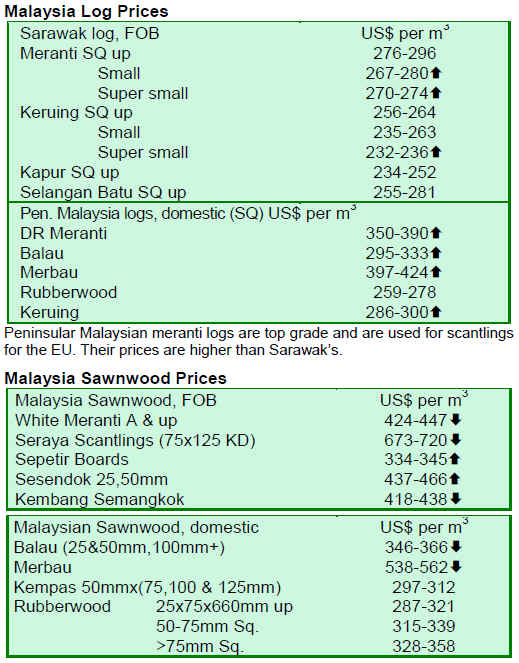
4.
INDONESIA
Indonesia responds to US government guidelines on certification
The Indonesian government acted quickly and positively
to set up a team of officials from various ministries to
address certification of the country¡¯s timber products for
the US market, reported The Jakarta Post. The Trade
Defense Director of the Indonesian Trade Ministry, Mr.
Martua Sihombing, commented that the team will be
composed of officials from the forestry, trade, agriculture,
finance, foreign affairs, and industry ministries and
representatives from the various timber trade associations.
The team has been given the task to determine and identify
procedures and constraints outlined under the US Lacey
Act, which establishes new guidelines for certified timber
products entering the US market. By July 2009, all timber
products entering the US market must be certified by
entities approved by the US government. Indonesia¡¯s
initial position will be known by 3 February 2009.
Sustainable Forest Management (SFM), Verification of
Legal Origin (VLO) and the Chain of Custody (CoC)
process will be addressed to meet the new guidelines. An
exporter can choose to utilize any of the three certificates
when exporting to the US. Indonesian Pulp and Paper
Association (APKI) chairman, Mr. Mohammad Mansyur,
said the Indonesian pulp and paper industry was ready to
comply with the required US regulations. Indonesian
Furniture and Handicraft Association (Asmindo)
chairman, Mr. Ambar Tjahjono, added that certification
was understandably necessary for wood products to
compete successfully in the global market. Indonesia¡¯s
global exports of wood products stand at USD2.48 billion
for the first 10 month of this year, down 3.9% from
USD2.58 billion for the same period in 2007, according to
the Indonesian Central Statistics Agency.
HSBC to scale back lending for forestry schemes in Indonesian and Malaysia
Reuters and The Guardian (UK) newspaper reported that
environmental concerns have caused HSBC, a major
British banking group, to scale down lending for forestry
schemes in Indonesia. HSBC will sever ties with a third of
forestry clients in Malaysia and Indonesia, including
clients involved in palm oil, soy and timber by end 2009,
according to Mr. Francis Sullivan, the bank¡¯s advisor on
the environment. HSBC is planning to terminate 30% of
client relationships in the forest land and forest products
sector in ¡®high-risk¡¯ countries, including Malaysia and
Indonesia, due to non-compliance with HSBC¡¯s forestry
policy.
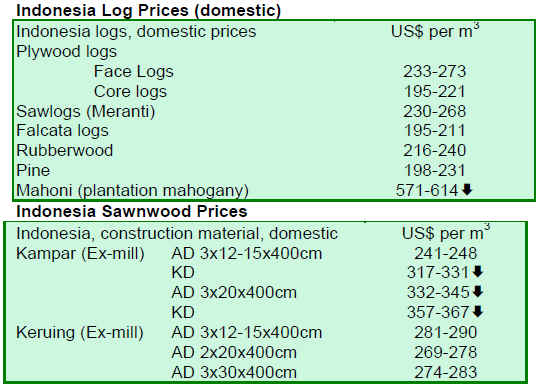
5.
MYANMAR
Prices hold steady as orders fall
The market situation for Myanmar teak and other non-teak
hardwoods has not improved over the last fortnight. Some
Indian buyers are shipping small quantities of teak and
gurjan, but in comparison to ground stock in Yangon, the
shipments have been minimal.
As reported in a previous TTM report (TTMR 13:21),
buyers hoped that the Myanmar Timber Enterprise (MTE)
might reduce its list price. Many buyers believe that the
six month average prices and the September 2008 list
prices may have aggravated the situation. While in its 60
year history, MTE has not needed to reduce prices it has
set, this may change due to the current effect of prices on
traders. Some buyers do not expect the situation to
turnaround soon. Analysts believe that MTE may need to
rethink its pricing strategy to alleviate the plight of buyers
and stockists (both foreign and domestic).
Local sawmills in Yangon are reported to be facing
difficulties due to high raw material prices and falling
orders. Exports of sawn timber are also down. One
representative from the industry noted that even if prices
of raw materials are adjusted, it would still be difficult to
run the sawmills, as there are no new orders from abroad.
The only possible way that MTE may be able to avert
future problems is to reduce felling in the current
harvesting season, thereby reducing supply. Analysts
admitted that it was not easy to anticipate this potential
move by the MTE.
The prices below are from November¡¯s tender sales. The
December tender will be held around 22 December.
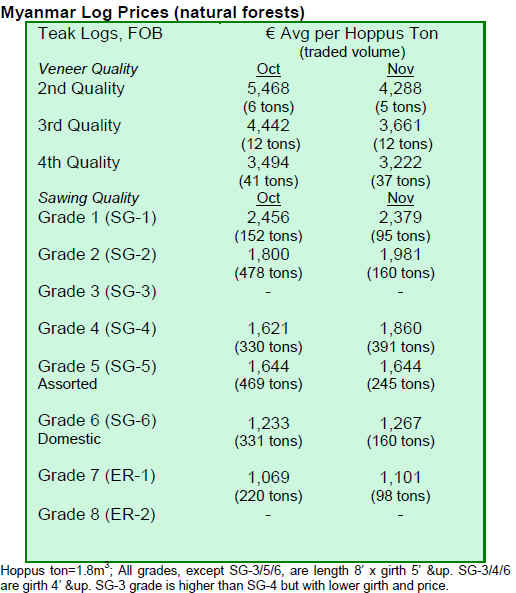

6.
BRAZIL
São Paulo promotes wood from legal sources
According to Cadmadeira/Di¨¢rioNet, the Secretariat of
Environment of the state of São Paulo recently launched
the State Registrar of Companies (CADMADEIRA)
commercializing forest products and by-products from
natural forests in São Paulo state. The registry, which was
launched in December, is voluntary, but according to the
Secretariat of Environment, only companies registered in
CADMADEIRA will be able to participate in the state
bidding process for wood supplies as of July 2009.
The Environment Secretariat has also designed a seal to
show forest products or by-products are from sustainable,
certified sources. This informs consumers about
companies that sell forest products and by-products in a
responsible manner, providing consumers with options to
buy wood from legal sources. To receive the seal, a
company should voluntarily adhere to CADMADEIRA
and will be subject to surveillance, certification and
evaluation before receiving the seal. The seal also certifies
that the company¡¯s tax situation is in conformity with
appropriate regulations and has no pending tax disputes.
The National Forum of Forest-Based Activities worked
decisively to establish CADMADEIRA. The decree that
created the organization also sets out the establishment of
a technical chamber for forestry matters to improve the
control system and promote forestry activities in the state
of São Paulo.
Wood waste shows income generation potential
During the last International Fair of the Amazon (FIAM),
the National Institute of Amazonian Research (INPA)
presented its project designed to create technologies for
the utilization of wood waste from sawmills and forest
management projects, reported Ag¨ºncia de Not¨ªcias da
Amazônia.
For example, with the technology developed at INPA,
sawmill waste, has been used in the art of marquetry,
which is a collage of different types of wood. The
technique of marquetry has been already used in the city
of Cruzeiro do Sul, in the state of Acre, where the
Yawanaw¨¢ Indians also have been manufacturing furniture
and wood handicrafts for decoration.
A researcher of INPA studied techniques of marquetry for
the manufacturing of products that are expected to bring
greater development to the region. According to INPA,
this marquetry wood work project benefits the company
that produces the artifacts, creates jobs in the region and
offers new business opportunities.
INPA studied the industrialization of lesser-known tree
species in the Amazon to implement the project and
conducted technological research on the quality of tree
species. At present, many people believe that only species
such as cedar and mahogany can be commercialized,
increasing the demand for these species, which end up
being overexploited.
The project has been supported by the Foundation for
Research Support of the State of Amazonas (FAPEAM)
and the National Funding Agency for Studies and Projects
(FINEP).
Storm affects Santa Catarina furniture industry
The furniture companies of São Bento do Sul and Rio
Negrinho municipalities, Brazil's main exporters, are
already facing difficulties meeting international delivery
deadlines after the recent flooding in Santa Catarina state.
Itaja¨ª Port, where 4% of Brazilian exports are shipped, was
closed as a result of the storm. Portal Moveleiro reported
that the storm, which hit the state at the end of November,
has caused economic problems along the entire supply
chain of timber and furniture. Santa Catarina is the leading
Brazilian exporter of furniture, with exports worth
USD378 million in 2007, or 32.8% of total Brazilian
furniture exports, according to the Federation of Industries
of Santa Catarina State (FIESC). Entrepreneurs are now
subjected to higher costs, complex logistics, renegotiation
of delivery dates with international customers, and risk
losing customers for breach of contract.
Since no furniture shipments were being made through the
Port of Itaja¨ª, product costs will be higher, as products will
need to be rerouted through the ports of São Francisco do
Sul (SC) and Paranagu¨¢ (PR). The costs of shipping
through these ports are now twice as high as shipping
through Itaja¨ª. Customers have not been accepting
renegotiation of contracts because they believe it is the
state¡¯s problem.
According to the Secretary of the Ministry of Foreign
Trade and Development (MDIC), Brazil's exports dropped
USD370 million by value in November 2008 because of
the severe damage at the Port of Itaja¨ª. For the Union of
Construction and Furniture Industries of São Bento do Sul
(Sindusmobil), logistical problems will add costs at year
end, since prices of contracts are already fixed. There are
no new contract negotiations scheduled for the moment.
Economic losses for the furniture industry in Santa
Catarina state is expected to be severe.
Africa may be potential market for Brazilian wood products
The Brazilian timber industry is actively seeking
alternatives to traditional North American and European
markets. According to the Brazilian Association of
Mechanically-Processed Timber Industry (ABIMCI),
economic growth of some African countries with growth
rates above 10% a year and countries with demand for
civil construction products such as South Africa, Angola,
Morocco and Egypt may represent potential markets for
the Brazilian solid wood industry.
Despite the small per capita consumption of these
countries, the population of the region is large and
economic growth has been accelerating, with their imports
above the world average. It is estimated that imports of
forest products by African countries may grow in the
coming years at rates higher than 8% a year. Imports of
wood products from Brazil by African countries are
diverse and focus on plywood, coniferous sawnwood,
wood panels and value-added products such as furniture.
Several African countries are both producers and exporters
of tropical timber, but do not produce much value-added
products; the majority of exports are logs and sawnwood.
In addition to obtaining a specialized market for furniture
products, another advantage in exporting to these countries
is the fact that there are no limitations with regard to nontariff
barriers.
Besides Africa, other developing countries represent
market alternatives for Brazilian companies. These include
markets in China, India, Taiwan and Vietnam, the United
Arab Emirates, Qatar and Saudi Arabia. In many of these
emerging countries, Brazil is already present, but there are
still opportunities to be explored.

7.
PERU
Peru¡¯s Environment Minister to raise funds for forest conservation
Peru¡¯s Minister of Environment, Antonio Brack, has
begun a journey to various European countries to raise
funds for environmental conservation. According to
Brack, Germany has already contributed EUR4 million to
the Ministry of Environment in Peru for rainforest
conservation. Some European countries have also
expressed interest in collaborating with Peru on
environmental conservation, he said. He added that he
would seek funds from countries in Asia, saying that he
had already established partnerships in Japan to conserve
and develop forests.
Brack explained that Peru, through the Ministry of
Environment, was making an international proposal to
preserve 54 million hectares of tropical forests. He noted
that the proposal would include protected Indian lands and
that carbon credits generated from this land would be sold
in the international carbon market. This way, he noted,
deforestation would not take place and biodiversity and
Indian culture would be preserved.
Peru has a number of projects addressing carbon
offsetting, which could be offered to different countries.
Minister Brack noted that Peru could collect over
USD5,800 million in the next few years if the 106
businesses carrying out environment projects with carbon
benefits are completed successfully.
Wood exports grow 9.6% in first three quarters of 2008
Wood exports from January to October 2008 were
USD194.20 million, up from USD177.25 million during
the same period in 2007. While this represents a 9.6%
growth in the value of exports, the growth has slowed in
2008 when compared to previous years, since exports to
main destination markets (Mexico, US and China) have
fallen. For instance, the total value of exports has dropped
in the Loreto region due to the lower imports from
Mexico.
From January to October 2008, exports were concentrated
in three main markets representing 84% of total exports of
the wood sector. Mexico represented 36% of these
exports, while China represented 28% and the US 20%. Of
total exports, sawnwood was the highest exported product.
Emerging markets for Peru¡¯s products were the Dominican
Republic, Italy and Hong Kong.
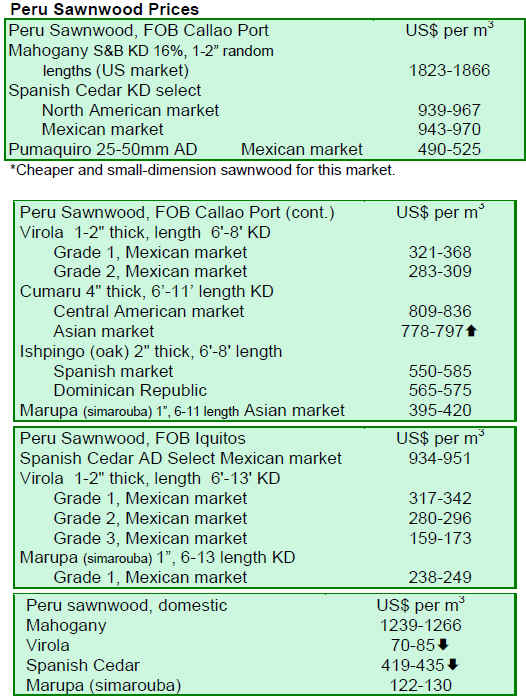
8. BOLIVIA

9. MEXICO
Mexico and Italy agree on bioenergy projects
The National Forest Agency (CONAFOR) and the
Ministry of Environment and Territory of Italy are
working together to reduce greenhouse gases and mitigate
climate change by generating bioenergy while preventing
forest degradation. The two countries signed a
Memorandum of Understanding in November 2008, and
Mexico has already started a national energy progamme,
which includes a programme to save firewood and reduce
the incidence of respiratory disease. In 2008, 185 million
Mexican pesos will be invested for the installation of
120,000 stoves in the country. Another component of the
program will promote commercial forest plantations for
the generation of biogas and bioethanol. Mexico and Italy
will promote technical and scientific cooperation for the
prevention of forest degradation and sustainable forestry
and exchange experiences on bioenergy generation to
promote sustainable development.
10.
GUYANA
Guyana¡¯s value added products continue record
growth
A year-to-date analysis of the volume and value of
shingles exported when compared to the same period of
2007 revealed gains of 16% by volume and an overall rise
of 57% by value. This robust growth by value is mainly
attributable to the higher price paid for shingles in the
Latin American/Caribbean markets and larger demand for
Guyana¡¯s shingles. Volumes of exports to these regions
have increased by 5.6% and 40% by value over the first 11
months of 2007. The average price received for shingles in
the Latin American/Caribbean market was 33% higher
than in other markets. Other main markets for Guyana¡¯s
shingles were in the African region, which has also shown
rises in the volume and value of shingle imports over 2007
levels. Prices of shingles to the region on average
increased 10% over prices in 2007. Despite lower volumes
of shingle exports to the North American market in 2008,
the value of these products were 12% greater than in 2007
and average prices jumped 69%.
In another added value product class, exports of kabukalli
doors showed marked improvements for the period
January to November 2008 by both volume and value
when compared to the same period of 2007. Increases of
30% by volume and 38% by value were recorded over the
review period. This was closely followed by
improvements in exports of locust doors, with gains of
65% by volume.
The highest volume of shingles exports has been seen over
the past fortnight, when compared to all other periods this
year. As projected in the last fortnight, log exports
continued to rise by both volume and value. Prices for logs
recorded average increases of 35% over the previous
fortnight¡¯s average. Sawnwood exports were also higher
over the last fortnight, 85% by volume and 80% by value.
The smaller improvement in value can be attributed to the
larger export volumes of less popular and commercial
timber species.
Guyana launches avoided deforestation model
On 5 December 2008, the Government of Guyana
launched a technical report, which will form the basis of
international support on avoided deforestation and for
climate change mitigation and adaptation. The document
recognizes the economic impact of deforestation across the
globe and uses a model to estimate economic losses from
deforestation to Guyana and the world. The report
concludes that while Guyana may benefit from short-term
gains from quick harvesting of its forest resources, a more
appropriate long-term strategy to align national and global
interests is necessary.
The President of Guyana, when presenting the model, said
funds generated from the market-based model on avoided
deforestation could help Guyana shift to using clean
energy technologies, which would supply low-carbon
electricity to the country. The President noted that targeted
funds could also provide an unprecedented amount of
assistance to forest communities and develop the economy
by expanding eco-tourism and other schemes and support
diversification of the economy. Other benefits identified
for Guyana under such an incentive scheme include
investing heavily in public development and upgrading the
sea defence and irrigation systems along coastal areas.
GFC and USAID host forum on US Lacey Act
The Guyana Forestry Commission and USAID Guyana
hosted a forum on the US Lacey Act on 11 December
2008. The forum was attended by stakeholders, including
both primary and added value producers, and exporters,
many of whom export to the United States.
At the meeting, representatives from the US Forest Service
presented the background and context of the recently
amended Lacey Act, the changes and new requirements
which are contained in the legislation, an outline of the
products that will be affected, the handling of violations
and upcoming developments regarding the implementation
of the Act. Several key areas within these general
discussion points were examined, including exclusions and
exemptions under the Act.
Several recommendations were made at the forum,
including: having access to a check list of requirements to
comply with the new provisions; the need for a core set of
documentation required for these provisions; and the
recognition of national level legislation in determining
legality of forest products harvested and traded. Guyana,
through the GFC, has identified trade relations with
international partners as a priority area for 2009, with
emphasis being given to the requirements of key markets,
including the US and EU markets.
At the forum, Guyana also discussed a legal verification
system it has developed. The system is expected to be
implemented in 2009.
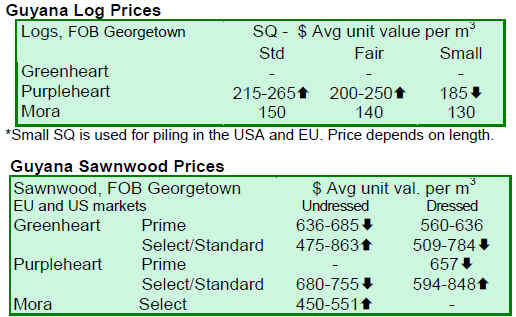
|